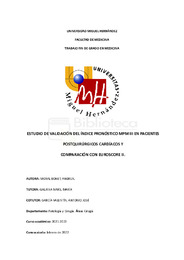Por favor, use este identificador para citar o enlazar este ítem:
https://hdl.handle.net/11000/28470Estudio de validación del índice pronóstico MPM III en pacientes postquirúrgicos cardíacos y comparación con EuroSCORE II
| Título : Estudio de validación del índice pronóstico MPM III en pacientes postquirúrgicos cardíacos y comparación con EuroSCORE II |
| Autor : Moral Bonet, Andrea |
| Tutor: Galiana Ivars, María García Valentín, Antonio José |
| Editor : Universidad Miguel Hernández |
| Departamento: Departamentos de la UMH::Patología y Cirugía |
| Fecha de publicación: 2022-01-25 |
| URI : https://hdl.handle.net/11000/28470 |
| Resumen : Introducción. Actualmente en las Unidades de Cuidados Críticos Quirúrgicos (UCCQ) no existe ningún modelo predictivo de riesgo estandarizado ni específico. Por este motivo, el objetivo de este estudio es analizar los parámetros de rendimiento (calibración y discriminación) del EuroSCORE II (European System for Cardiac Operative Risk Evaluation II), modelo validado específicamente en pacientes postquirúrgicos cardíacos, y el MPM III (Mortality Prediction Model III) que es de uso general en las unidades de pacientes críticos. De esta forma, podremos determinar si el MPM III es adecuado para la valoración pronóstica del paciente cardíaco postquirúrgico. Material y métodos. Se ha realizado un estudio observacional, retrospectivo y transversal de una muestra de pacientes operados de cirugía cardiovascular e ingresados en la UCCQ del Hospital General Universitario de Alicante (HGUA) durante el año 2020. Se calculó la mortalidad estimada por el MPM III y el EuroSCORE II y se comparó con la mortalidad observada. Para evaluar la calibración de los modelos se empleó la prueba de bondad de ajuste de Hosmer-Lemeshow (HL) y para la discriminación se utilizó el área bajo la curva ROC (Receiver Operating Characteristic). Resultados. Se incluyeron un total de 249 pacientes. La mortalidad observada fue del 4,4% y la tasa de complicaciones fue del 43,8%. Los valores medios del MPM III y el EuroSCORE II fueron de 6,3% y 3,6%, respectivamente. En la calibración del MPM III se observó una Odds Ratio (OR) significativa de 1,11 (IC 95% = 1,05 a 1,18) junto con un buen ajuste en el test de bondad de HL (p=0,5), mientras que el EuroSCORE II evidenció una OR no significativa de 1,09 (IC 95% = 0,98 a 1,21) con un mal ajuste en el test de bondad (p=0,05). El área bajo la curva (AUC) ROC para el MPM III fue de 0,76 (IC 95% = 0,70 a 0,81) y para el EuroSCORE II fue de 0,72 (IC 95% = 0,66 a 0,77). Conclusiones. El MPM III muestra una buena calibración con unos valores aceptablemente buenos de discriminación para este subgrupo de pacientes, por lo que podría ser empleado en la práctica clínica diaria de la UCCQ, aportando información relativa a la probabilidad de complicaciones y mortalidad de los pacientes críticos postquirúrgicos cardíacos. Introduction. Currently, Surgical Intensive Care Units (SICU) do not have any specific severity of illness scoring method that can be widely used in this environment. For this reason, the aim of this study is to assess the performance (calibration and discrimination) of two prediction models: EuroSCORE II (European System for Cardiac Operative Risk Evaluation II) and MPM III (Mortality Prediction Model III). EuroSCORE II is a risk model specifically validated in patients undergoing major cardiac surgery, whereas MPM III is a scoring system commonly used in the Intensive Care Units (ICU). Analysing these parameters, we can evaluate the performance of the MPM III in the cardiac surgical patient’s prognosis assessment. Material and methods. An observational, retrospective and single-centre study was performed. It included a sample of patients who had undergone major cardiac surgery and were admitted to the SICU during 2020 in the Hospital General Universitario de Alicante (HGUA). Estimated mortality was calculated for each model and it was compared to the observed mortality. The calibration was evaluated with Hosmer-Lemeshow (HL) goodness-of-fit test and discrimination with the area under the ROC (Receiver Operating Characteristic) curve. Results. Two hundred forty-nine patients were included in the study. Observed mortality was 4.4% and the complication rate was 43.8%. The mean expected mortality rate was 6.3% for the MPM III and 3.6% for the EuroSCORE II. Referring to calibration, statistically significant differences were not found between observed and expected mortalities when using MPM III (p=0.5) with a significant odds ratio (OR) of 1.11 (CI 95% = 1.05-1.18), while these differences were found with EuroSCORE II (p=0.05) with a non-significant OR of 1.09 (CI 95% = 0.98-1.21). Areas under the ROC curves (AUC) were 0.76 (CI 95% = 0.70-0.81) for MPM III and 0.72 (CI 95% = 0.66-0.77) for EuroSCORE II. Conclusions. MPM III showed good calibration and acceptably good discrimination in cardiac surgical patients. According to these findings, MPM III could be a useful model in SICU by providing information regarding to mortality and complications prediction in this group of patients. |
| Palabras clave/Materias: Risk prediction MPM III EuroSCORE II Surgical intensive care Cardiac surgery Mortality |
| Área de conocimiento : CDU: Ciencias aplicadas: Medicina |
| Tipo de documento : info:eu-repo/semantics/bachelorThesis |
| Derechos de acceso: info:eu-repo/semantics/openAccess Attribution-NonCommercial-NoDerivatives 4.0 Internacional |
| Aparece en las colecciones: TFG- Medicina |
 La licencia se describe como: Atribución-NonComercial-NoDerivada 4.0 Internacional.
La licencia se describe como: Atribución-NonComercial-NoDerivada 4.0 Internacional.
.png)
